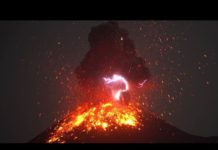Geology Professor James L. Anderson demonstrates techniques researchers use for collecting samples of molten lava. If you’re interested in studying geology, come earn your undergraduate degree here at the University of Hawaii at Hilo, where geology goes beyond textbooks.
In general, scientists collect samples of molten lava for later analysis in the laboratory, to compare the chemistry from one eruption to the next, which provides clues as to the source of the magma supply below—is it fresh magma from the hot spot, or is it from an existing or evolving magma chamber, or a mixture? Samples of molten lava (2000 degrees F; 1200 C) are quenched in a can of water, and they immediately turn to glass; slower cooling would allow the lava to become rock.
Note the scientists are wearing heavy-duty clothing, gloves, and boots for this operation. Some of the “lava sampling” shown here is more of a demonstration of viscosity of lava, especially the last scene, in which hardened crust is brought up on the rock hammer.
Video Copyright © CenterStudyVolcanoes










![Scientists discover 36-million-year geological cycle that drives biodiversity Mesozoic mural depicting different ocean species that have evolved through time. [Credit: Smithsonian Institution]](https://www.geologypage.com/wp-content/uploads/2023/08/Scientists-discover-36-million-year-geological-cycle-that-drives-biodiversity-GeologyPage-218x150.jpg)





